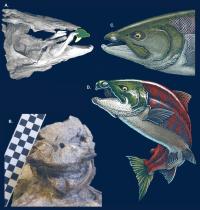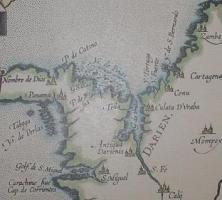Copy Link
Add to Bookmark
Report
Current Cities Volume 12 Number 07

Current Cites
Volume 12, no. 7, July 2001
Edited by [2]Roy Tennant
The Library, University of California, Berkeley, 94720
ISSN: 1060-2356 -
http://sunsite.berkeley.edu/CurrentCites/2001/cc01.12.7.html
Contributors: [3]Charles W. Bailey, Jr., [4]Margaret Gross, [5]Terry
Huwe, [6]Shirl Kennedy, [7]Leo Robert Klein, [8]Margaret Phillips, Jim
Ronningen
Allen, Maryellen M. [9]"Bluetooth Bites Information Retrieval
[10]Online 25(3) (May 2001)
(http://www.onlineinc.com/onlinemag/OL2001/allen5_01.html). -
Futurists and sci-fi buffs have long envisaged a world of wireless
communication through a small portable device, be it a watch or gadget
loaded special eyewear. A new enabling technology standard which has
the potential to make this vision a reality is Bluetooth. Maryellen
Mott Allen's article is an excellent introduction to both the
underlying technology, and and its applications for libraries and
librarians. She begins the article by citing market studies which
demonstrate an exploding market for Bluetooth enabled devices. Tracing
the history and technological construct of Bluetooth in layman's
language, she kindles the reader's curiosity for further
investigation. To this end it is best to start at the [11]Official
Bluetooth SiG website (http://www.bluetooth.com). Named after Harald
Bluetooth, the son of Denmark's first king, Bluetooth is an open data
transmission standard developed by Ericsson. A who's who of hi-tech
companies, such as Microsoft, Intel, Nokia, Toshiba, etc. now form the
Bluetooth Special Interest Group, which is committed to developing low
power, high speed, short range devices compatible with the Bluetooth
data transfer standard. The benefits of interactive wireless are
boundless. Imagine connecting to remote database servers, accessing
information resources on various platforms, creating ad hoc working
groups where data is instantly shared, anywhere and everywhere. There
are, however, problems which have to be addressed. These include
security issues, and device incompatibility from competing
technologies such as the one defined in IEEE 802.11b. The
communications revolutions continues -- stay tuned. - [12]MG
Carlson, Scott. [13]"JSTOR's Journal-Archiving Service Makes Fans of
Librarians and Scholars" [14]Chronicle of Higher Education 47(46)
(July 27, 2001): A26-A28
(http://www.chronicle.com/free/v47/i46/46a02601.htm). - This overview
of JSTOR, the non-profit digital archiving project, could almost have
been written by the project's own PR department. It seems there's not
much bad you can say about an organization whose mission is to
"preserve and maintain journal literature, and to make that material
more accessible" and who -- in this time of dot.com excess and greed
-- are not only turning a blind eye to profit but have even offered
rebates to early subscribers who bought into JSTOR when the costs were
higher. Criticisms of JSTOR -- that smaller institutions can't afford
to subscribe and that building a digital archive only encourages
libraries to trash their print back runs -- do not, in this citer's
opinion, hold up against the advantages. Think about it: you can
search the full-text of an entire run of an important scholarly
journal from home. Besides, how many organizations do you know that
can gain the respect of both librarians and publishers? - [15]MP
Case, Mary M. [16]"Public access to scientific information: Are 22,700
scientists wrong?" [17]C&RL News 62(7) (July/August 2001):
706-709,716. (http://www.ala.org/acrl/case.html) - Close to
twenty-three thousand and counting -- that's the number of scientists
who've signed the open letter available at the [18]Public Library of
Science site pledging to only publish in journals that make the
articles freely available to the public six months after their initial
publication. When Current Cites last reported on this in [19]April
2001, the number of scientists who had signed was 15,000. In this
article by Mary M. Case, we are given some more background information
on the initiative as well as suggestions for how librarians can do
their bit. - [20]LRK
[21]Free Online Scholarship Newsletter
(http://www.earlham.edu/~peters/fos/). - [22]Peter Suber, chair of the
Philosophy Department at Earlham College, established the electronic
Free Online Scholarship Newsletter in March of this year. This
newsletter, which is distributed via a Topica mailing list, is an
excellent way to stay informed about current scholarly electronic
publishing developments. Suber makes no bones about his position in
the ongoing debate about the economics of scholarly electronic
publishing: he wants it to be subsidized and free to users. He also
wants it to be uncensored. Even if you don't agree with these
positions, you are likely to find the newsletter to be a valuable, if
provocative, source of information. If you don't want to subscribe to
the mailing list, read the Web-based [23]issue archive periodically.
There is also a [24]discussion forum. And, of course, it's all free.-
[25]CB
Galbi, Douglas A. [26]"Some Economics of Personal Activity and
Implications for the Digital Economy" [27]First Monday 6(7) (July 2,
2001) (http://www.firstmonday.org/issues/issue6_7/galbi/). - The
author places the "buzz" about the "attention economy" in a very
useful historical context. He charts economic study of personal
attention to media from 1925 to the present, assessing user behavior
long before anyone every heard of the Web. However, some important
historical facts from this longer period emerge. First, increases in
personal time spent with media follow increases in total personal
discretionary time. Second, the share of advertising spending in total
economic output is more or less constant. Third, advertising spending
per person-hour spent with media has also been roughly constant. The
upshot, Galbi argues, is that the traditional approach of buying
personal attention through media advertising will not support the
extremely rapid growth of the digital economy. Instead, the growth of
the digital economy is more likely to be driven by the growth of
discretionary time and integration of digital technology into new
forms of socializing. - [28]TH
Holden, Stephen H., ed. "A Symposium on International Applications of
Electronic Government (E-Government): Research, Practice and Issues"
Government Information Quarterly 18(2) (2001). - The editor of this
symposium issue thinks that 'e-government' might be the management
reform buzzword of the new century. There's certainly a lot of
pressure to achieve, or at least be perceived as achieving, this type
of governmental weight-loss; public opinion has the 'e' standing for
'efficient' and just wants to see the bloat reduced. The articles here
are a smorgasbord of ways to think about, implement, and last but not
least, watchdog e-government projects. The availability of online
state legislative information is analyzed in an article that assesses
progress in access, usability and search features. Canadian efforts
are described in a report that focuses on the difficulty of changing
administrative culture (and gives us the "International" in the title
-- otherwise, the focus is pretty domestic). The US Dept. of Energy's
Office of Scientific and Technological Information has, not
unexpectedly, been a leader in the electronic dissemination of
research results; their successes are related in a study that
quantifies the activity around their [29]primary website. On a more
theoretical level, there's an article laying out a four-stage model
for e-gov projects which can effectively 'cut across the silos' of
vertically arranged information repositories. Finally, there's a
critique of the study by the US National Commission on Libraries and
Information Science, [30]"A Comprehensive Assessment of Public
Information Dissemination: Final Report, Vol. 1" which finds that its
recommendations could perpetuate technologically obsolete mechanisms,
and provide no reasonable model for electronic archives. - JR
James, Michael S. [31]"Fading Bits of History" [32]ABCNews.com (July
9, 2001)
(http://abcnews.go.com/sections/scitech/DailyNews/preservation010708.h
tml) - Too many people believe that backing their electronic data up
to tape, CDs, etc. is a safe way of preserving it for the long haul.
Alas, these media seem to deteriorate even faster than paper, and data
stored on them "requires frequent conversion from old storage media,
like computer disks and magnetic tapes, to newer ones." The author
talks to Brewster Kahle, founder of the Internet Archive
(http://www.archive.org/) and some other digital preservation experts
such as Ken Thibodeau, director of the electronic records archives
program at the National Archive (http://www.nara.gov/). Article
includes links to related stories and more detailed information. -
[33]SK
Koerner, Brendan L. [34]"Click Here for Britney" [35]Washington
Monthly (July/August 2001)
(http://www.washingtonmonthly.com/features/2001/0107.koerner.html). -
This article explores the dark side of "AOL's evolution into one of
America's most popular news outlets." Substantive objective journalism
providing coverage of hard news and public affairs is scarce, despite
the fact that AOL now has any number of Time, Inc.'s impressive stable
of magazines from which to pull content. Alas, pandering to the lowest
common denominator attracts more eyeballs and advertising dollars. The
author is especially pessimistic about what will happen as AOL extends
its brand into interactive and cable television. - [36]SK
Latham, Joyce M. [37]"Positioning the Public Library in the Modern
State: The Opportunity of the Children's Internet Protection Act
(CIPA)" [38]First Monday 6(7) (July 2, 2001)
(http://www.firstmonday.org/issues/issue6_7/latham/). - The author
argues that the public library in the United States today is an
essential avenue for the development of debate on the entire range of
topics that face the society: political, social, economic, and
recreational. She explores the ramifications and impact of the
controversy over the Children's Internet Protection Act, on the
library in general, and on the relationship between patron and
librarian. She argues that in order to fulfill its role the public
library must be immune to the imposition of any particular orthodoxy
of belief. The Children's Internet Protection Act is the most concrete
challenge to the library as a marketplace for ideas and the primacy of
the citizen's right to research, and offers the profession a new
opportunity to redefine itself as a guardian of the public good that
stands above orthodoxy. - [39]TH
Pogue, David. [40]"A Final Internet Freebie on the Phone" [41]New York
Times (July 12, 2001)
(http://www.nytimes.com/2001/07/12/technology/circuits/12STAT.html). -
Among the fallout from the great dot-com debacle is that many useful
free services have dried up and blown away. Oddly enough, freebie
voice portals seem to be thriving. If you're on the road or otherwise
away from a computer, you can dial up a popular portal -- MSN, Yahoo!,
etc. -- and get your news, sports scores, stock quotes, soap opera
updates, whatever. Even more useful, travelers can obtain
up-to-the-minute airline arrival and departure information, traffic
reports, and driving directions. Some of these portals will even read
your e-mail to you. [42]SK
Rhodes, John S. [43]"The Usability of usability : an interview with
Jared Spool, Founding Principal of User Interface Engineering"
[44]WebWord.com (July 25, 2001)
(http://webword.com/interviews/spool2.html). - The state of usability
by one of its foremost practitioners is what we're served up in this
interview with Jared Spool, author of the classic "Web Site Usability
: A Designer's Guide." Spool sees a welcomed shift in emphasis in this
field from "preachers of a religion of sorts" to "researchers of best
practices". He also points out that usable sites depend not so much on
having a stable of usability experts on hand but rather on developing
a "culture" of usability in-house. The results of his research -- much
of it concerning e-commerce -- can apply, he feels, to "non e-commerce
sites" as well. - [45]LRK
Smith, Suzanna et. al. [46]"GNOME Usability Study Report" Sun GNOME
Human Computer Interaction (HCI), Sun Microsystems, Inc. (July 2001)
(http://developer.gnome.org/projects/gup/ut1_report/report_main.html).
- Even if you've never heard of GNOME -- the open-source effort to
provide a user-friendly interface for Linux -- you might be interested
in this study conducted by the usability team over at Sun Microsystems
(http://www.sun.com/usability/). It goes over the kind of problems
users ran into while trying to solve various "tasks". In turn, the
study offers solutions -- some of which you may agree with or not.
Graphics clearly show the state of the interface now and how suggested
improvements can be made. Independent of the subject matter then, this
is a clear and instructive example of usability in action. - [47]LRK
Spink, Amanda, and Gunar, Okan. [48]"E-commerce web queries: Excite
and Ask Jeeves Study" [49]First Monday 6(7) (July 2, 2001)
(http://www.firstmonday.org/issues/issue6_7/spink/). - The authors
report on a study of business related queries submitted to the
[50]Excite and [51]Ask Jeeves Web search services. They sampled a log
of 10,000 Excite queries and 10,000 Ask Jeeves question format
queries, and make a few conclusions about the oh-so-organic process of
research. First, business queries often include more search terms,
lead to fewer Web pages viewed, and include fewer advanced search
features than non-business queries. Second, company or product queries
were the most common form of business query; and third, Ask Jeeves
business queries in question form were largely limited to the format
"Where can I buy..." or the request "I want to buy ...". Librarians
will be shocked to find out that business terminology and the open Web
are not standardized and make the process very difficult for the
average user. Maybe that's not news to many of us, but it supports the
case for better analysis tools that can track the formulation of
questions. Interesting tabulations of search strategies are another
highlight to be found here. - [52]TH
Sullivan, Danny [53]"Search Engines and Legal Issues"
[54]SearchEngineWatch.com (July 2, 2001)
(http://searchenginewatch.com/resources/legal.html#Crawling%20And%20Li
nking). - If you're a webmaster, it's a scary world out there.
Lawyers, apparently, are lurking in every corner of cyberspace.
Sullivan keeps an ongoing annotated collection of links to articles
about various search engine-related lawsuits in a number of
categories: advertising, crawling and linking, domain names,
government regulation, labor, meta tags, meta search, multimedia
search, pagejacking, patents, privacy and user information and
trademarks. Read 'em and weep. - [55]SK
Tweney, Dylan. [56]"Slim Down That Home Page" [57]Business 2.0 (July
13, 2001) (http://www.business2.com/articles/web/0,1653,16483,FF.html)
- While it's not news to most information professionals, Tweney
maintains that "too many sites are weighted down by graphics and Flash
animations." He gives some examples of "good" and "bad" pages, and
includes Jupiter Media Matrix's recommendation that Web pages should
"weigh" no more than 40 or 50 KB. These will take 8-10 seconds to
download over a typical 56K connection -- "about the limit of most
people's patience." He also reminds Web page designers than an
increasing number of people are accessing sites via very slow wireless
connections on devices with small screens. - [58]SK
White, Martin. "Behind the Firewall: A Case for Formal Intranet
Leadership" [59]Econtent 24(5) (July 2001). - Martin White, managing
director of a U.K. intranet consulting company makes a compelling case
for sophisticated expertise in the management of intranets. Oh the
plight of the intranet webmaster, isolated behind corporate firewalls!
There is little or no chance to glean tips and tricks from competitor
or client intranet sites. This is in marked contrast to the internet
webmaster who can surf the web for ideas. Often managing an intranet
is a peripheral task for already preoccupied librarians and
information specialists. Furthermore, usually there is no budget for
intranet activity. Mr. White envisages the intranet webmaster as a
vice president/director of intranet operations. The required skills
are a complex mix of information technology savvy, knowledge of web
design principles, excellent communication skills, the ability to
build teams, and what could be called "information content
architecture." As intranets are becoming the primary corporate tool
for information transfer and sharing, certainly recognition of the
intranet webmaster, appropriate funding, and higher visibility are a
must. - [60]MG
_________________________________________________________________
Current Cites 12(1) (January 2001) ISSN: 1060-2356
Copyright © 2001 by the Regents of the University of California All
rights reserved.
Copying is permitted for noncommercial use by computerized bulletin
board/conference systems, individual scholars, and libraries.
Libraries are authorized to add the journal to their collections at no
cost. This message must appear on copied material. All commercial use
requires permission from the editor. All product names are trademarks
or registered trade marks of their respective holders. Mention of a
product in this publication does not necessarily imply endorsement of
the product. To subscribe to the Current Cites distribution list, send
the message "sub cites [your name]" to
[61]listserv@library.berkeley.edu, replacing "[your name]" with your
name. To unsubscribe, send the message "unsub cites" to the same
address.
References
1. http://sunsite/cgi-bin/imagemap/cc
2. http://escholarship.cdlib.org/rtennant/
3. http://info.lib.uh.edu/cwb/bailey.htm
4. http://www.cam.org/~mgross/mgross.htm
5. http://www.lib.berkeley.edu/autobiography/thuwe/
6. http://web.tampabay.rr.com/hooboy/
7. http://patachon.com/
8. http://www.lib.berkeley.edu/autobiography/mphillip/
9. http://www.onlineinc.com/onlinemag/OL2001/allen5_01.html
10. http://www.onlineinc.com/onlinemag/OL2001/oltocmay01.html
11. http://www.bluetooth.com/
12. http://www.cam.org/~mgross/mgross.htm
13. http://www.chronicle.com/free/v47/i46/46a02601.htm
14. http://www.chronicle.com/
15. http://www.lib.berkeley.edu/autobiography/mphillip/
16. http://www.ala.org/acrl/case.html
17. http://www.ala.org/acrl/more.html
18. http://www.publiclibraryofscience.org/
19. http://sunsite.berkeley.edu/CurrentCites/2001/cc01.12.4.html
20. http://patachon.com/
21. http://www.earlham.edu/~peters/fos/
22. http://www.earlham.edu/~peters/hometoc.htm
23. http://www.topica.com/lists/suber-fos/read
24. http://www.topica.com/lists/fos-forum/read
25. http://info.lib.uh.edu/cwb/bailey.htm
26. http://www.firstmonday.org/issues/issue6_7/galbi/
27. http://www.firstmonday.org/
28. http://www.lib.berkeley.edu/autobiography/thuwe/
29. http://www.osti.gov/
30. http://www.nclis.gov/govt/assess/assess.html
31. http://abcnews.go.com/sections/scitech/DailyNews/preservation010708.html
32. http://abcnews.go.com/
33. http://web.tampabay.rr.com/hooboy/
34. http://www.washingtonmonthly.com/features/2001/0107.koerner.html
35. http://www.washingtonmonthly.com/
36. http://web.tampabay.rr.com/hooboy/
37. http://www.firstmonday.org/issues/issue6_7/latham/
38. http://www.firstmonday.org/
39. http://www.lib.berkeley.edu/autobiography/thuwe/
40. http://www.nytimes.com/2001/07/12/technology/circuits/12STAT.html
41. http://www.nytimes.com/
42. http://web.tampabay.rr.com/hooboy/
43. http://webword.com/interviews/spool2.html
44. http://webword.com/
45. http://patachon.com/
46. http://developer.gnome.org/projects/gup/ut1_report/report_main.html
47. http://patachon.com/
48. http://www.firstmonday.org/issues/issue6_7/spink/
49. http://www.firstmonday.org/
50. http://www.excite.com/
51. http://www.ask.com/
52. http://www.lib.berkeley.edu/autobiography/thuwe/
53. http://searchenginewatch.com/resources/legal.html#Crawling%20And%20Linking
54. http://searchenginewatch.com/
55. http://web.tampabay.rr.com/hooboy/
56. http://www.business2.com/articles/web/0,1653,16483,FF.html
57. http://www.business2.com/
58. http://web.tampabay.rr.com/hooboy/
59. http://www.econtentmag.com/
60. http://www.cam.org/~mgross/mgross.htm
61. mailto:listserv@library.berkeley.edu
62. http://sunsite/Admin/copyright.html
63. http://escholarship.cdlib.org/rtennant/
64. mailto:manager@sunsite.berkeley.edu





















